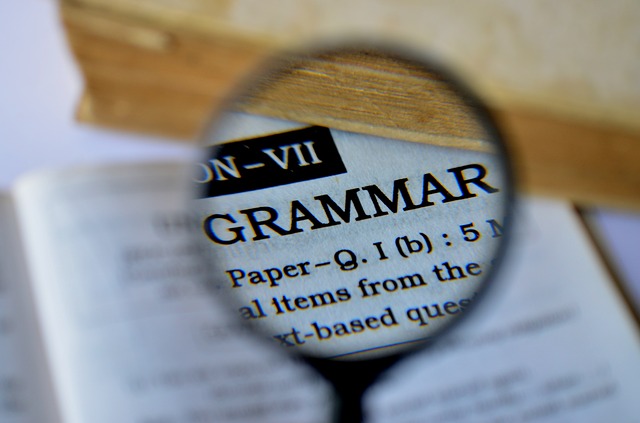Grammar Spotlight
 The English Grammar Profile (EGP) is a sister resource to the English Vocabulary Profile, and has been put together by Anne O'Keeffe (Limerick University) and Geraldine Mark, the co-authors, along with Ron Carter and Mike McCarthy, of English Grammar Today (Cambridge University Press). Mark and O'Keeffe investigated the extensive data in the Cambridge Learner Corpus to establish when learners begin to get to grips with different linguistic structures.
The English Grammar Profile (EGP) is a sister resource to the English Vocabulary Profile, and has been put together by Anne O'Keeffe (Limerick University) and Geraldine Mark, the co-authors, along with Ron Carter and Mike McCarthy, of English Grammar Today (Cambridge University Press). Mark and O'Keeffe investigated the extensive data in the Cambridge Learner Corpus to establish when learners begin to get to grips with different linguistic structures.
A series of insights from their research will be posted on this page, each one putting the spotlight on an interesting aspect of learner grammar development. Please note that all of the learner examples come from the Cambridge Learner Corpus, a 55-million word electronic collection of written learner data. The examination and the candidate’s first language are given in brackets after each learner example.
See the latest Grammar Spotlight entry below. Scroll right down to the bottom of this page to browse through previous entries.
The main development at the C1 level is seen in the use of either and neither. Learners are able to use either and neither with singular nouns at the C1 level.
 Second, we would draw your attention to the fact that neither party could foresee or predict the recent rise in the price of wheat. (Cambridge English: Legal; Russian)
Second, we would draw your attention to the fact that neither party could foresee or predict the recent rise in the price of wheat. (Cambridge English: Legal; Russian)
 In the Czech Republic, somewhere between those two extremes, either way is possible. (Cambridge English: Advanced; Czech)
In the Czech Republic, somewhere between those two extremes, either way is possible. (Cambridge English: Advanced; Czech)
 This way, the toilet can be accessed easily from either floor. (Cambridge English: Advanced; Chinese)
This way, the toilet can be accessed easily from either floor. (Cambridge English: Advanced; Chinese)
They can also use either and neither + of with plural noun phrases or pronouns.
 Either of the measures is recommended and those measures are bound to enhance the company’s competitive power. (Cambridge English: Business Higher; Chinese)
Either of the measures is recommended and those measures are bound to enhance the company’s competitive power. (Cambridge English: Business Higher; Chinese)
 Of course if you are not at all interested in sports, neither of these games will be of any interest to you. (Cambridge English: Advanced; Swedish)
Of course if you are not at all interested in sports, neither of these games will be of any interest to you. (Cambridge English: Advanced; Swedish)
 However, you forgot to add that neither of us could foresee the rise in the price of wheat. (Cambridge English: Legal; Polish)
However, you forgot to add that neither of us could foresee the rise in the price of wheat. (Cambridge English: Legal; Polish)
Learners at this level can also use determiners in hyperbole (millions of, loads of, tons of) often in informal contexts.
 My kitchen is absolutely cramped. I love cooking and despite the fact that I have no space, I managed to fit in a table as well as millions of cookbooks and all the necessary kitchen tools. (Cambridge English: Advanced; German)
My kitchen is absolutely cramped. I love cooking and despite the fact that I have no space, I managed to fit in a table as well as millions of cookbooks and all the necessary kitchen tools. (Cambridge English: Advanced; German)
 I’m going to make loads of cookies this year and will give them in nice little boxes to my family and friends. (Cambridge English: Advanced; German)
I’m going to make loads of cookies this year and will give them in nice little boxes to my family and friends. (Cambridge English: Advanced; German)
 I received tons of plastic ducks every time I had my birthday or some kind of celebration. (Cambridge English: Advanced; Greek)
I received tons of plastic ducks every time I had my birthday or some kind of celebration. (Cambridge English: Advanced; Greek)
Once the C2 level is achieved, learners are able to accurately use many a or many an + singular noun for emphasis and focus.
 We have come a long way and climbed many a mountain but are we really better off than our ancestors? (Cambridge English: Proficient; Polish)
We have come a long way and climbed many a mountain but are we really better off than our ancestors? (Cambridge English: Proficient; Polish)
 Her father’s pharmacy was broken into very often, the local drug addicts were relentless and Mary was threatened many a time on her way home from work. (Cambridge English: Proficient; Greek)
Her father’s pharmacy was broken into very often, the local drug addicts were relentless and Mary was threatened many a time on her way home from work. (Cambridge English: Proficient; Greek)
 It has raised many an issue which I would like to comment upon here. (Cambridge English: Proficient; Russian)
It has raised many an issue which I would like to comment upon here. (Cambridge English: Proficient; Russian)
So, by the time the C2 level is achieved, learners are able to demonstrate an awareness of context in their use of determiners of quantity and show focus. Although the expansion made to the range of determiners of quantity is much lower at these levels than it is at B1, the progress made by learners remains significant as they move through the highest of CEFR levels.






